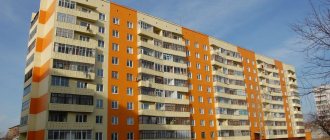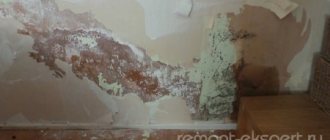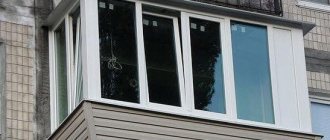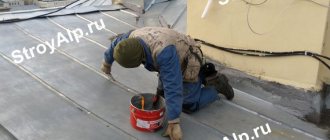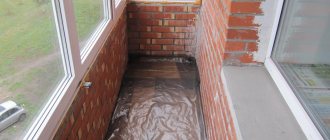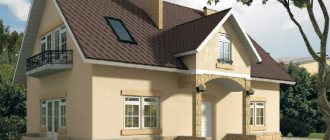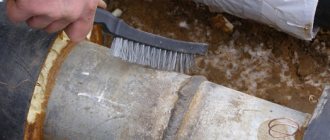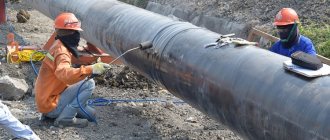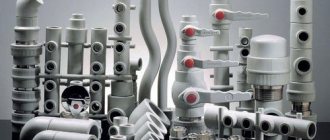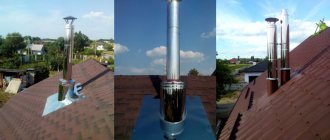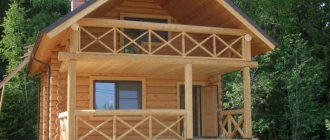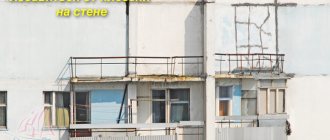Home / Articles / How to properly insulate interpanel seams in a panel house / Repair of interpanel seams and the technology for their insulation / How to determine the series of a house and calculate the volume / How to seal interpanel seams in an apartment / Sealing seams - determining the price / Who should repair interpanel seams in a house / How force the management company to seal the interpanel seams? / Reasons for the appearance of mold on the walls of an apartment / The walls in a panel house freeze, what should I do? / Typical mistakes in sealing joints between panels / How is the technical condition of interpanel joints, roofs and balconies inspected? / Frequently asked questions about sealing seams, what should I do if the seams are leaking? / How to get rid of fungus and mold on the walls of an apartment / Album of technical solutions: insulation and repair of open and closed joints / Technical instructions for sealing joints of prefabricated buildings with polymers
Primary sealing
It is carried out during the construction of a building and includes the following stages:
The seam between the panels is filled with foam; it provides not only insulation, but also additional waterproofing;
Vilatherm is placed in the seam. This is insulation with a high elasticity index, made from foamed polyethylene. The material may be cylindrical, sometimes with a hole inside. Thanks to its elasticity, the material can withstand repeated stretching and compression, which is important when a new house undergoes shrinkage. When laying the material, you need to ensure that it fits tightly to the concrete surface. If connections are made to vilates of different diameters, then the upper edge is trimmed with a wedge downwards, and the lower edge – upwards.
A sealant (mastic) is applied over the vilatherm; if all work is done correctly, the seam should be completely sealed.
Often, insulation and sealing of the seam is carried out without the use of foam; this is acceptable and does not greatly affect the final result.
Now let's look at what mistakes are most often made when sealing interpanel joints?
For insulation, only polyurethane foam is used. Some companies consider this a simplified option, but our specialists do not use this technology, as it has disadvantages. Over time, the house will settle, causing the slabs to move. Polyurethane foam is not elastic, therefore, as a result of the movement of the slabs, the integrity of the foam will be compromised, which means water and cold will freely penetrate into the seams.
Use of low-quality Vilaterm. The use of high-quality insulating material is a very important fact, so we check the quality of vilatherm every time we purchase it. In our practice, there have been cases when, with vilatherms, such material does not provide a tight fit to the panels, that is, the material simply falls out of the seam.
Using vilatherm of the wrong diameter. When laying, it is important that it fits tightly to the walls of the seam and is in a compressed state.
Incorrect connection of insulation. One of the common mistakes that leads to the destruction of the sealing material and the opening of the seam.
Secondary sealing
Repeated work on sealing the joints between the slabs can be carried out using two technologies:
Without opening the seam. New sealant is applied to the old sealant (mastic joint repair) or over the concrete joint. In this case, it is very important that the seam is cleared of foreign debris and elements that are weak to adhere to. A carpet brush is used to clean the joint, after which the seam is treated with a solvent.
The second option involves opening the seam and completely cleaning it, removing the old sealing material. For cleaning, a hammer drill and a chisel and hammer are used to remove old material. After which the seam is degreased and goes through the stages of primary sealing.
Often, when carrying out this procedure, companies with unqualified employees make a mistake - poor-quality cleaning of the seam from old material.
Instructions for sealing seams when repairing panel buildings.
1.1. This instruction is a guide when performing work on sealing seams of external walls and window (balcony) blocks during the repair of prefabricated buildings. 1.2. The instructions are intended for engineers, craftsmen and sealing workers. 1.3. This instruction contains the requirements for the performance of work on sealing the joints of external walls and window (balcony) blocks during the repair of prefabricated buildings. 1.4. Sealing of seams of external walls and window (balcony) blocks must be carried out by sealing workers who have undergone special training and have a certificate for the right to carry out sealing work. 1.5. When performing repair sealing, only materials specified in the project should be used. Replacement of sealing and sealing materials provided for by the project is allowed only in agreement with the organization that authored the project. Repair sealing of interpanel seams should be provided for in the working drawings of building projects or in work organization projects. Read more.
TOP
A little about the technology of sealing interpanel joints
The simplest and cheapest sealing option is to coat the joints, but unfortunately, this method does not bring the expected results, moisture penetrates the seams and enters the home, drafts continue to flow along the walls and bring cold into the home.
The fact is that during rain, a large amount of water collects on the roof of the bay window and it flows along the seams, constantly leaking into the apartments, especially in areas where a vertical seam intersects with a horizontal one. The surface sealing method is often used by home management companies, where the main thing is to make the work look like it is done, and not to do the job properly.
Sealing the seam between the panels and filling it with foam is a good option, although not strong enough. This technology involves drilling the seam to create holes through which the void between the panels will be filled with polyurethane foam. This method is usually used when the distance between the slabs is minimal or the interpanel seams are firmly closed with cement-concrete mortar.
At the same time, there is emptiness in such seams and dampness and cold pass through them into the room. In addition, when a building settles, the slabs always shift and cavities form, which can expand over time, especially in the seams, since this is the weakest point.
It is impossible to lay vilatherm from the outside, so the voids are filled with foam, and the seam from the outside is covered with mastic. With a competent approach and compliance with all technologies, this is a fairly reliable method, especially if the foam is not affected by climatic influences.
Methods and technology for repairing joints
The main requirement for high-quality repairs is the use of correctly selected high-quality materials and step-by-step implementation of the work production technology. There are usually 3 repair methods:
- joint putty;
- waterproofing works;
- “warm seam”.
Work on sealing the joint is carried out without opening it and replacing the sealant. Mastic is applied over it from above. This method of repair is used if there are no visible signs of a violation of the seam seal inside the apartment, and the damage to the outer layer of sealant is insignificant. These works are usually carried out during cosmetic repairs.
Waterproofing of joints occurs with their complete cleaning and replacement of sealant. Insulation of joints is not done in this case. Typically, a one-component polyurethane sealant is used for interpanel seams and joints Germaflex 127. This material is ideal for insulating vertical joints, has a wide operating temperature range (-50°C...+80°C), and hardens quickly. White or gray, compatible with all types of facade paints. The warranty period is 8 years. Sealing interpanel seams using this technology will help protect them from moisture, but cold will penetrate into the room through unsealed horizontal joints. Sealing external seams is work to prevent water from entering them. To do this, waterproofing compounds are used and the seam between the panels is filled with polyurethane foam, which creates an insulating effect.
Thus, the foam is completely contained between the slabs and is protected from ultraviolet rays. This extends its service life. The sealant protects the joints of the slabs and prevents water from entering them. As a result, the sealed joint eliminates the appearance of fungus and mold in the room.
[flat_ab id=”35"]
Warm seam
This is one of the most effective and common methods. To implement it, the joint cavity is foamed and vilaterm is placed in it, after which a layer of sealant is applied to the surface of the seam. At first glance, the “warm seam” technology is impeccable, but as practice shows, it also has disadvantages, or rather difficulties in operation. Panel slabs are produced with a thickness of 20 cm, while vilatherm is 3-4 cm, with another 16 cm remaining, but there are slabs with a greater thickness and this space will remain empty. The seam will be protected for several years, but then the vilatherm will turn into dust, begin to crumble, and the problem with the seams will again become acute for the owners. If the joint is heavily foamed, the foam will push both the vilatherm and the sealant out, which is, of course, unacceptable. Therefore, when using the “warm seam” technology, the joints must be foamed very carefully. It is described in more detail and in detail with examples on the page about sealing interpanel seams
How to fill joints with foam from the inside.
— Remove the baseboards from the external walls (which separate the apartment and the street). — Drill holes in the corners and along the entire junction of the outer wall with the floor and ceiling in increments of 20 cm. — Fill the seam into the drilled holes with polyurethane foam until the foam comes back. Fill the corners to a greater extent. — Wait until the foam dries, then cut off the excess dry foam. In any case, filling with foam from the inside will not harm, but will additionally insulate your room.
See on topic:
Professional sealing of interpanel seams and insulation of the interpanel space is necessary work to forever rid your home of leaks, freezing and mold. Read more.
Repair of interpanel seams:
Major repairs of interpanel seams are carried out only using the “Tight seam” technology developed by the group’s engineers. According to which SNiP was subsequently adopted on sealing the seams of large-panel buildings. Read more.
Insulation and sealing of window seams and junctions:
In order to get rid of mold around the windows, the windows are sealed - sealing the joints and junctions of double-glazed windows and the panel, insulating the junctions of the sills and the panel. Read more.
TOP
Sealing seams in panel houses
In this case, it is assumed that the joint between the panels is completely filled, where the final stage is the application of a sealing layer of mastic. When the material is completely foamed, it comes out, so it doesn’t make any sense to lay Vilatherm and mastic right away. You need to wait a few hours, or better yet a day, until the foam gets stronger, then you need to remove its excess, lay the vilatherm and apply mastic. If the joints are filled through holes that are pre-drilled, then the technology is the same. Foam is injected into the holes, which are then tightly closed. The foam, not finding a way out, is forced to fill all the voids inside.
Is it necessary to open the seam?
There are a number of factors under which the seam must be opened, namely:
- The material from the seam disintegrates when struck with the sharp edge of a climbing hammer;
- The seam is surface plastered and a light layer of sealant is applied to it;
- The wall is very old and the material falls off even with a light touch.
Such seams must be opened, filled and sealed. If the seam is securely concreted or the slabs fit tightly enough to one another, then tearing down the walls is not recommended. It is more advisable to drill neat holes and foam the voids. Some people believe that in order to ensure thermal insulation of the seam, it is necessary to lay vilatherm. This is not so, the fact is that vilatherm itself does not provide heat, it only protects the seam from the penetration of cold by “sealing” the joint. If the seam is foamed correctly and reliably, then heat leakage will not occur.
Sealing seams and joints of metal structures.
Prefabricated metal structures, various hangars, warehouses, require sealing of seams. The main reason for the leakage of the roof of such metal structures is that the joints between the roofing sheets are poorly attached to the sheathing. And the gap between the sheets is quite large. A large gap will leak regardless of the amount of sealant used to seal the seam. The only correct method of roof repair is to eliminate large gaps between the sheets of the structure, and then seal the joints of the metal structure.
Features of sealing interpanel seams
Today, before starting renovations on apartments in a new building, owners have to wait several years for the house to settle. As a result of settlement of the house, voids and cracks form between the slabs, which must be repaired. Houses that were built during the cold period have a number of disadvantages. The panels often did not always have time to dry thoroughly and reached their condition already during the construction process. As a result, due to temperature changes and high humidity inside the slab, its integrity was compromised, since in cold weather the water inside the concrete froze and destroyed the slab.
Sealing of joints between panels should be carried out during the construction stage. The work should be carried out from an elastic material that has good resistance to the negative influences of the environment, because practice has already proven that the structure of solid materials is quickly destroyed due to the constant (even microscopic) movement of panel slabs.
Insulation of interpanel seams
The fact that insulating a panel house from the outside is more effective than from the inside is a fact that is unreasonable to dispute. Additional thermal insulation is resorted to when the temperature in the room does not meet your requirements. At the same time, many consider the insulation of external walls in panel houses as the only option to create a comfortable indoor environment, forgetting about the specifics of construction from concrete panels. Also read: “How to measure the temperature in an apartment, where to go.”
There are gaps between the plates that must be completely sealed. You can’t rely on the highest degree of responsibility of builders, so it also happens that there is blowing from the corners. But this does not necessarily happen due to someone’s negligence; the insulating material ages, deteriorates, nothing lasts forever. Replacing old insulation and high-quality sealing of seams can completely remove the issue of insulating external walls in panel houses.
Contractors offer several options for sealing joints between panels:
- primary sealing;
- secondary sealing;
- warm seam
Primary insulation of seams in panel houses includes laying the Vilaterm sealing harness and applying sealant (mastic).
The work is carried out at new facilities where the seams were not previously sealed. Secondary insulation is carried out with or without opening the seam, where the joints are already insulated and sealed. If the seam does not open, then only sealing with mastic is carried out. Naturally, the surfaces are first cleaned of dust.
Materials for insulating seams in panel houses.
If the seam is opened, then everything happens according to the already known scenario of primary sealing, only everything that was in it is first removed from the joint. If only you knew what they are missing from the seams, even rags. The most capital option is to insulate seams in panel houses using the “warm seam” technology:
- the joint is opened and all the insulation is removed from it;
- internal surfaces are cleaned with a metal brush, dust is removed;
- if necessary, joints are treated with antiseptics against fungi;
- the seam cavity is blown out with polyurethane foam;
- Vilaterm is installed;
- the joint is covered with mastic (such a sealant).
Now let's look at the materials and tools for insulating interpanel seams in panel houses. The joints are opened using a special hammer for industrial mountaineering. On the one hand, it is sharp, the head of the tool is hardened and galvanized, there is a movable ring for attaching to a safety system and a hole for creating a carabiner chain. The weight of the tool is just over 0.7 kg, the length of the handle is about 30 cm, the length of the head is about 15 cm.
If there is no special hammer, use a regular chisel, but this is not very convenient, since both hands are involved. The foam for the seams is two-component polyurethane with a minimum percentage of expansion (Makroflex pro) so that the sealing strand does not squeeze out. Vilaterm is a product made of foamed polyethylene, similar to a cover for insulating pipes, only without a longitudinal section. Due to the air cavity inside the bundle, its thermal insulation qualities become higher. The diameter of Vilaterm is selected so that it is slightly larger than the seam and is inserted with some effort. Work is carried out only in dry and windless weather, minimum temperature -15 degrees.
To carry out repairs of heating boilers, you must have the appropriate permits. It’s better not to go there yourself at home, besides, modern units have a very complex design, so as not to completely break them. Therefore, turn to professionals.
You can read about how to repair the heating system in an apartment yourself here. And remember the proverb: “If you don’t know the ford, don’t go into the water.”
Seam sealing at a professional level
To ensure thermal and waterproofing, it is necessary that all joints and cavities between the slabs be filled and sealed. Only properly sealed seams provide comfortable and healthy living conditions. As practice has shown, the most effective method of insulation today is the “warm seam”.
In the past century, the seam was filled with tow and rubber; recently, new materials and techniques have appeared on the market, which have made it possible to significantly improve the technology of sealing seams and guarantee high results. For this purpose use:
- Swellable cords made on the basis of hydrophilic rubber;
- Cement mortar is common;
- Dowels and specialized profiles.
But such sealing methods cannot give a good result due to:
- Different thicknesses of gaps between plates;
- Chips and microcracks of slabs;
- A defect that could occur as a result of non-compliance with construction technology.
Houses made of sandwich panels once received an unfortunate practice. The first buildings built using the new method had to be strong and warm, since the structure was made of two strong slabs. But over time, it turned out that there was an empty space between the panels, although in theory it should have been filled with insulation, in practice it was not there, as a result, air accumulated in the empty space, which created drafts. Due to the large number of empty cavities, such houses did not warm up well and cooled down quickly. Condensation led to the formation and active reproduction of mold and mildew, which became faithful neighbors.
Step-by-step sealing of interpanel seams
Sealing seams in buildings of this type is a very painstaking and time-consuming job that requires experience and specific knowledge. Our company’s employees, thanks to many years of experience, have been able to master the technology of closing seams for such houses.
To reliably fill the seams, our employees use special foam, which, when expanded, penetrates even small cracks and reliably fills all voids. Vilater blocks the foam from escaping to the outside, as a result, the entire flow goes inside, and the sealant reliably protects the seams from moisture penetration.
Internal insulation of the facade
Internal insulation of the facade is an ideal option when you need to change the situation in only one apartment. You do not need to obtain special permits or negotiate with neighbors. Inside the apartment you are your own masters.
Insulating the walls from the inside will add about 10-15 cm to them. This method actually involves a major overhaul of the insulated wall. The procedure begins with dismantling the trim and plaster. Afterwards, all the cracks and cracks in the façade wall are identified. They are filled with compounds with special additives. After this, the wall is prepared, then a deep penetration primer is applied.
Next comes a very important stage, at which you should under no circumstances save (don’t forget that adherence to technology is the key to success!). We are talking about treating the joints with hydrostop followed by applying a vapor barrier. This procedure will further protect your apartment from moisture penetration from the outside. If the work is done poorly, mold, fungi, and pathogenic organisms may appear from excess moisture.
The penultimate stage is applying a layer of insulation. For interior work, mineral wool is recommended (primarily because it is non-flammable, unlike foam or polystyrene boards). The thickness of the insulation is calculated depending on the thickness of the walls. If you want to save money, you can consider using roof insulation (for example, stone wool insulation boards). Savings can be achieved by reducing consumption (a smaller thickness of the base layer is required).
After installing the insulation, the surface is plastered. We recommend using plaster with insulating properties.
The last stage is finishing - here the choice is yours: you can hang wallpaper, paint the walls or choose something else. Nothing will threaten the finishing for a long time, since you thought about vapor barrier in advance.
Protection of the upper floors should begin with sealing the seams
The reputation of panel houses suffers greatly due to poor waterproofing, especially on the top floors. In most cases, the space between the slabs in such buildings is not filled with anything, and this is a fact proven by practice and experience. In addition, the roofing material of balconies and loggias does not meet the waterproofing requirements.
The technical floor becomes a place where rainwater steadily accumulates after every rain, which penetrates into the apartments through drainage channels and empty seams, and the upper floors are the first to suffer.
To free your apartment from the constant penetration of dampness, drafts and cold from the roof, it is enough to properly insulate the joints and repair the roof on the loggia. To do this, craftsmen remove the old material and lay in a new one that has good strength and elasticity. Additionally, the work uses a burner and special modern waterproofing materials. Next, waterproofing of vertical joints in the area of the customer’s apartment is carried out on all floors. Afterwards, the joints between the panels are cleaned, where vilatherm and polyurethane foam are laid. Afterwards, the seam must be thoroughly coated with waterproofing material – mastic. Only compliance with this technology can guarantee a high result of waterproofing work and provide dry and warm walls in the premises.
The edge of a concrete wall with joints is often jagged and uneven, so if the joints are not sealed carefully, they begin to leak. The problem is that the seams on the inside of the slab are inaccessible for work, so the only solution is to carefully waterproof the joints on the outside.
Sealing seams in different types of houses
Sealing technology is selected for each home and case individually, since there are many factors that must first be calculated and taken into account. At the same time, craftsmen also consider the economic feasibility of using one or another sealing method.
Our company uses the “warm seam” technology for its work; today this is perhaps the only reliable, proven method that gives high results. The secret of our company is that we use our own, improved and time-tested technology for waterproofing seams. We use Vilaterm as a sealant, a material characterized by high wear resistance, Macroflex sealant and Oxyplast mastic.
Previously, houses of the KOPE type were built from sandwich panels that were empty inside. The tightness of the adhesion of such panels was simply terrible; as a result, the houses were not distinguished by good thermal insulation and airtightness.
Let us say right away that sealing seams using foam does not bring the desired result due to the specifics of the material; the foam did not linger in the seams after filling, but spread throughout the interpanel space. To achieve good tightness, a vilatherm seal is used. This material has already proven its effectiveness in ensuring tight sealing of seams and sealing.
In houses of the p.44 and p.44t series, problems periodically arise associated with chips on the slabs or with the formation of large seams between the panels, through which heat leaves the house, a draft penetrates from the street and condensation forms. In winter, such walls are not protected from the cold, as a result, fungus and mold become permanent residents in such apartments, and drafts also add to the dampness.
In such cases, interpanel joints are sealed using the “warm seam” technology. If the width of the joint does not allow the use of Vilaterm insulation, the seam is reliably foamed and covered with sealant on top. Construction foam has good resistance to environmental influences and can perform its functions for a long time.
To be fair, it should be noted that blown seams are not only a drawback of panel houses. Monolithic brick buildings also face this problem; poor sealing is especially often observed at the junction between the brickwork and the concrete monolithic floor. Similar problems also often arise at the junction of brickwork and windows. From personal experience, we can say that such seams must be sealed very carefully, using not only foam, but also sealed plaster.
Types of sealing panel seams
When constructing new buildings, sealing joints was not put in first place. The priority was usually the speed of construction. For sealing, simple tow or glass wool was often used; sometimes builders used rubber sealing materials. After installing the material, the connection was sealed with cement mortar, then it was simply greased.
In the first few years, any house will shrink, albeit slightly. With a minimal shift of the panel parts relative to each other, a crack can be created in a previously sealed joint, which will make the structure accessible to the penetration of cold and rain. A simple option for sealing the interpanel joint - in the same way as the builders.
This type of sealing of interpanel seams, according to the proposed technology, is the simplest and does not require large financial investments. But there is no guarantee that the structure will not move another millimeter and that a crack will not form again.
Therefore, it is worth familiarizing yourself with other sealing options and choosing the most suitable one for yourself. It is imperative to seal the seams in a panel house, because the normal condition of the premises depends on this.
How to repair seams:
- Exterior cosmetic renovation. This type of sealing is the simplest. It can be used if there is no strong displacement of the seams, they are almost completely intact. The method is considered cheap, but the efficiency is low.
- If there are small (up to 15%) defects in the coating, the technology of partially opening the connection can be used.
- The best option, which is higher than others in cost, is sealing using “warm seam” technology.
It is impossible to seal an apartment from the inside, no matter how well the work is done. The main work should be carried out from the street.
If work is being done to insulate the apartment, sealing seams, it is worth doing work in the apartment itself, it will not be superfluous. The joints that will be opened are filled with insulating elements, and then filled with mortar. Such events will only have a slightly noticeable positive effect, and there is no 100% guarantee that the apartment is reliably insulated.
The situation will not change much. The sealing of interpanel seams and the technology for its implementation must be known to the people performing the work and strictly observed by them. If there are irregularities in the work, there is a risk of incorrect execution, and all the work will be in vain.
The seams must be insulated on both sides. There will be no significant improvements if the sealing of joints is carried out only inside the house, also because it is necessary to make the connection of the slabs closed along its entire length, and this cannot be done inside the home.
Liquid that got inside the seam two floors above can easily seep into the apartment and create many problems. Therefore, if possible, it is best to seal the entire area of the house by teaming up with neighbors, which will allow the work to be carried out successfully.
Sometimes it is impossible to bring equipment and lifting structures to the house, which are designed to reduce financial expenditure during insulation, in order to cover up some of the connections. The cost of work may vary; the price will differ significantly if there is a need to call industrial climbers who seal at high altitudes.
Home renovation
This type of repair is carried out without opening the connections. The sealing of interpanel seams does not increase significantly. It is considered the cheapest method of eliminating seam problems. Taking into account the technology of work, repair of interpanel seams should be carried out only if the slabs are perfectly connected outside the house.
Sealing of any interpanel joints after such repairs is not allowed. Seal the interpanel seams to make the house much warmer.
Before insulating interpanel seams, it must be examined for defects. Afterwards, if necessary (although, most often, this happens), the old mastic is removed using a spatula. If the cement is in good condition, there are no cracks or chips, you can perform this type of finishing. But in reality, it is very rare to find a high-rise building with ideal condition of wall joints.
Events carried out with joints:
- The joint is cleared of resin.
- Once cleaned, it must be treated with a soil solution that must have a deep penetrating effect. A fungicidal additive is added to such mixtures, created to fill all voids.
- If necessary, the joint is sealed with cement mortar in places where the integrity of the structure is damaged. The insulation of seams in panel houses should be carried out efficiently, cement should be placed so that there are no gaps, because the further result of the entire work depends on this.
- Afterwards it is covered with a water-repellent mixture (mastic). Many types of it are sold; one- and two-component solutions are available. Understanding the difference between mixtures will help you choose among many. Specialists prefer to work with two-component solutions, because the seams provide a more reliable sealing of interpanel and other joints; there are no defects due to low-quality material.
The mixture is mixed using a mixer; all work is carried out in accordance with the instructions. Sealing of panel seams must be carried out so that the seam is slightly larger than the joint. To make the sealed groove look better after completing the work, you can glue the joints with masking tape, which is removed after all the work is completed.
Repair with partial opening of the seam joint
Interpanel seams should be carefully examined to identify any existing defects. In case of visible damage to part of the coating, the sealing of the slab joints should be carried out in the following sequence:
- The first step is to remove the cement that does not seal the joints tightly. It is completely removed in places of poor fit. If it is necessary to remove only a certain piece, holes are drilled every 20-25 mm, which will then need to be closed;
- It is necessary to pour polyurethane foam into these holes in an amount until it begins to come out of them. You can use a foam gun to make work more convenient. Waterproofing of interpanel seams must be done with high quality, this should be monitored to prevent defects;
- After the polyurethane foam has completely hardened, you need to remove the part that protrudes beyond the edges of the building. The joint must be treated with a primer, and the places that were opened and drilled holes must be plastered;
- Then, in the seams, all joints are filled with mastic. The thermal insulation here is high, and you can save a lot on heating costs.
There is a high need for using polyurethane foam, because this is the only way to fill the voids between the slabs that have undoubtedly managed to form there.
Warm seam technology
The highest quality and most reliable method of sealing seams is considered to be working using this technology. The price for the work will differ from a simple cosmetic repair, and the total cost will depend on the length of the area being repaired.
The technology for repairing interpanel seams involves performing work in the following order:
- The joint in the slabs is opened completely, along its entire length. The technology for sealing interpanel seams does not allow partial opening of the channel.
- All pieces of old insulation must be removed.
- If necessary, severely damaged parts of the panels must be repaired.
- All surfaces must be primed. Large seams in a panel house need to be sealed efficiently, avoiding errors.
- The space must be filled with polyurethane foam; you should definitely remember its properties - compaction and expansion. Do not forget that it can increase in size by 2 or even 3 times. Therefore, when the material has penetrated into the joint, it is worth filling about ¼ of the total volume of the channel with it. Then, if required, add the compound little by little until the seam is completely closed. The sealant will work only if there are no voids inside the joint.
- After the foam begins to increase in volume, insulation based on polyethylene foam should be placed in the joint. This material will help the foam stay inside the seam and prevent it from creeping out of the channel. It will fill not the outer border, where it will then need to be cut off, but the inside of the seam, all the bends and voids. Special material is prepared for the sealed areas.
This seal is usually found in the form of tubes that are empty inside, but material filled inside is also available for sale. In size, it should be slightly, about 10% larger than the connection itself, but it must be installed with a spatula, lightly pressing it into the putty - polyurethane foam. This product should not be damaged during work, so care should be taken. The joints must be sealed with polyurethane foam to prevent voids from forming. If this requirement is not met, all the work will be done in vain.
- Sealing of interpanel and other seams must be carried out in a certain sequence. The outer boundary of the joint, the slab, must be flush with the material. To complete the sealing, it is necessary to apply mastic in the sequence indicated in the paragraph above. The sealing of interpanel seams in panel houses, the technology of work and all the nuances must be observed. Otherwise, minor inaccuracies will lead to slow destruction of the connection.
The use of technology will provide the owners with warmth. The materials are considered one of the best on sale today; after their use, the interpanel seam will become waterproof, and this will make the home inaccessible to the penetration of liquids. In addition, the wear resistance of the entire building increases, since it will not be destroyed from the inside. To seal the seams in any panel house reliably, this type of sealing is suitable.
It is better to entrust the work to professionals. You can do it yourself in the area of 1 or 2 floors, installing reliable loess for the implementation. On higher floors, it is wise to use the services of climbers. The technology for insulating interpanel seams eliminates all problems, and it is difficult for a person who has not encountered such work to carry out such activities.
Sealing joints that were previously plastered
Often, instead of sealing, utility workers simply plaster the walls and seams, but these actions do not solve the problem, the void between the seams remains, water and cold air constantly penetrate into apartments, as a result, the home is cold and uncomfortable, fungus and mold develop, which not only allows you to create comfortable living conditions, but also negatively affects the health of residents. Over time, dampness destroys the plaster layer and cracks open.
Of course, it is not always necessary to open the seam completely. Such measures are taken if the joint between the panels is narrow or the plaster is held tightly, then construction foam is used. Holes are made in the plastered seam, every 20-30 cm, foam is released through them, which penetrates into all the cracks and fills the entire space. Afterwards, a layer of sealant – mastic – is applied to the plaster; this coating will provide additional protection against moisture penetration.
Why is insulation necessary?
Concrete panels themselves are a source of cold. Increased heat transfer occurs through concrete, which leads to significant heat loss in the apartment. But that's not so bad. The thinnest point of such construction is the interpanel seams. Although the seams are insulated at the frame installation stage, this is not enough. There are several reasons for the problem:
- Hasty installation;
- Poor quality materials;
- Displacement of the plates relative to each other during shrinkage;
- Chips at the joints of products;
These and many other circumstances force us to resort to re-sealing.
Insulating materials do not just prevent the formation of cold bridges. They help to hold the structure together, which has a positive effect on its durability. In this case, minor displacements and deformations can be avoided.
Protection from the penetration of dampness and cold reduces their harmful effects on the frame. In this case, the service life is extended. Education is also excluded:
- mold deposits;
- fungal organisms;
- ice;
- yellow damp spots
Sealing seams at the joints of loggias and windows
The design of loggias and balconies implies the presence of joints between the slabs and walls, through which water can penetrate during rain. Constant dampness negatively affects materials, destroys them, develops fungus in them, and mold appears on the walls and ceiling. If the loggia is also blown out, then the furniture and materials on them begin to deteriorate, and there is nothing to say about comfort.
To eliminate drafts and moisture penetration inside, you need to provide sealing. Before starting work, the loggia must be carefully examined by employees of the sealing company, which will allow you to first draw up a competent work plan and select the necessary materials.
What advantage does sealant have over other building materials?
According to its technical characteristics, the sealant has good elasticity, which allows the material to adapt to external changes, slab shifts and other deformations that may occur as a result of the operation of the building. A high-quality sealant withstands exposure to sunlight well and is a reliable protection for foam, which can collapse under the influence of UV rays. At the same time, the sealant protects the foam not only from sunlight, but also from moisture, and prevents the formation of flax, mold, and fungus inside the seam.
Our specialists use only materials proven by experience and time, which provide long-term safety for the seam and the apartment (house) from moisture.
A question or request for work using the warm seam technology method for a panel building can be submitted to the contact phone +7 (495) 585-79-00 or sent right now: Order
Frequently asked questions about sealing seams: / How to properly seal internal seams between slabs / Who should I repair the interpanel seams in my house? / Sample application to the Management Company for the repair of interpanel seams / Secrets of correctly writing an application for interpanel seams in the management company / Reasons for the appearance of mold on the walls of an apartment / Walls freeze in a panel house, what should I do? / Typical mistakes in sealing seams between panels
